September 11, 2020
A few weeks ago, I wrote about cauliflower, AKA rose, coral, a species that grows in spherical bouquets on Hawaii’s tropical reefs (as well as reefs throughout the Pacific and Indian Oceans.) Because fish, crabs, and shrimp (photo below) like to hide in the C-shaped arms of these coral heads, I can’t pass one up without a peek inside.
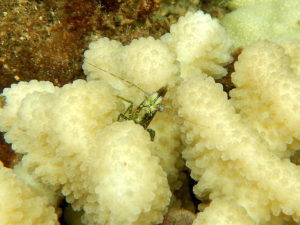
A flattened coral shrimp, Harpiliopsis depressa. These flat shrimp live in cauliflower coral heads, usually coming out only at night. This week, I got lucky to see one in the early morning. ©Susan Scott
Nor can I resist admiring the variety of colors the colonies’ symbiotic algae give them, perfect pictures of pinks, greens, and tans.

Cauliflower corals of Hawaii often seem empty but the deep crevices between their arms offer good hiding places for a variety of crabs, shrimp and fish. ©Susan Scott
But not all are so perfect. In some of the coral colonies, I’ve noticed clamshell shapes that remind me of grinning packmen. And on the tips of some cauliflower arms are tiny brown circles surrounded by pink and white tints.
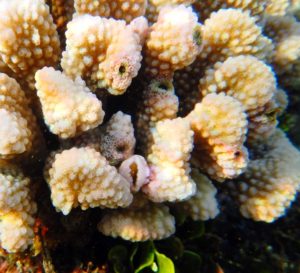
These odd bumps and circles are made by members of a squatter family called Cryptochiridae, tiny crabs that create swellings called galls, and channels called chambers, inside cauliflower, and several other, stony corals. Inside the galls and chambers are females of the species.
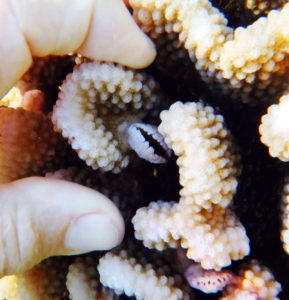
The hollow swellings, called galls, in corals resemble clamshells.©Susan Scott
Females inside the hollows are trapped for life, having grown too big to exit. The females likely eat mucus secreted by their coral hosts and also filter nutrients from passing water.
Males, smaller by far, come and go, fertilizing as many females’ eggs as they can manage. The tiny males of both species slip in and out of the grinning galls and circular chambers as they please, the ultimate good deal for polygamous males.
The little clamshell shapes, called galls, are made by the coral gall crab, Hapalocarcinus marsupialis. The marsupial word in the species name comes from the fact that the trapped female, which grows to about ½ inch wide, carries her eggs in a pouch, kangaroo style. The brown circles surrounded by pink are chambers made by another species, the Utinomiella dimorpha.
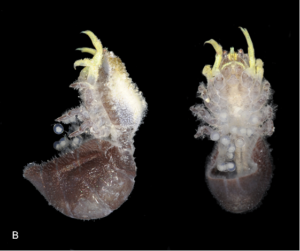
The female coral chamber crab, Utinomiella dimorpha, outside of its chamber. Researchgate: bit.ly/3ia4dhC
In some species of the Cryptochirdae family, the back shell of the female fits to close the opening of the tunnel, like a snail’s operculum, or cat’s eye.
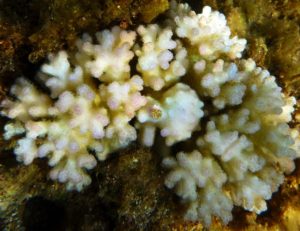
A chamber (brown circle, center) of a coral chamber crab in a lace coral, a close relative of cauliflower coral. ©Susan Scott
After noticing and photographing several cauliflower corals’ deformities, I thought they must be infected by parasites. But no. The relationship between the corals and crabs is called commensal, meaning the crab benefits but the coral stays healthy, eating, growing, and reproducing around its little crab condos.
After blowing up my photos of the corals’ lesions and the flat coral shrimp, I spent days trying to remember where I had seen similar pictures. I found them, as usual, in John Hoover’s excellent book, “Hawaii’s Sea Creatures, A Guide to Hawaii’s Marine Invertebrates,” (Mutual Publishing, Honolulu, Revised, 2012.) bit.ly/3bHHw1D
Thank you, John, for enlightening me during my recent obsession with the cauliflower coral community. It’s been a comforting diversion from world news.